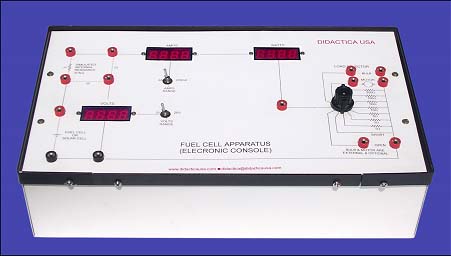ROMTEK BASIC HYDROGEN FUEL CELL APPARATUS
Model No: |
NCE-01 |
Romtek® is the registered trade mark of Bhushan & Bhushan
Short Description
Solar Group Expts (S.1 to S.5) Fuel Cell Group Expts (F.1 to F.5) S.1 Measurement & Plotting the short circuit Current (Isc) & No load voltage (Voc) of Solar Panel for incident radiation of different intensity. F.1 Measurement & Plotting of Gas Generation rate vs intensity of light S.2 Measurement & Plotting of Solar Panel Output (Current (I) & Voltage (V)) as a function of distance from the radiation source. F.2 Determination of Electrolysis Efficiency S.3 Measurement & Plotting of Solar Panel Outputs (I & V) as a function of angle of incident light. F.3 Measurement & Plotting the characteristics curves (V vs I) and (P vs I) of Fuel Cell. S.4 Measurement & Plotting of characteristics curves of (I vs V) & (P vs V) Solar Panel, determination of Maximum Power Point (MPP), and Filling Factor (FF). F.4 Measurement of Faraday Efficiency & Energy Efficiency of Fuel Cell S.5 Measurement of Efficiency of Solar Cell F.5 Measurement of ‘Mileage’ of Fuel Cell Car S.6 Calibrating radiation meter F.6 Measurement of ‘horse power’ of the Fuel Cell Car “engine” Solar Modules Dimension 4 3/2 ”X 5 ½” X ¼ “ (120 X 135 X 5) mm Open Circuit Voltage 3.0 V DC Short Circuit Current 245 mA MPP Voltage 2.4V DC MPP Current 200 mA MPP 480 mW Data on standard conditions of 1000 W/m2 at 25o C Reversible Fuel Cell (PEM) Dimension 2 ½ “ X 2 ½ “ X 3/5 “ (65 X 65 X 15) mm Mode 1 Electrolyzer Input Voltage 1.4 – 1.8 V DC Storage Volume (H2) Storage Volume (H2) : 20 cc Storage Volume (O2) 10 cc Mode 2 Fuel Cell Output Voltage 0.4 to 0.9 V Power Output 400 m W Model Automobile Car with geared electric Motor & Crane facility Dimension (Axle to axle)/(Wheel to wheel) 6 ½” X 4 ½ “ X 5 ½ “ Driving Voltage 0.5 to 3.0V Driving Current 100 m A @ 0.6 V no load Hydrogen Consumption 3-5 mL / min Crane Attachment Provided Light Source with Dimmer Input Voltage 220 V, 50 Hz(110 V, 60 Hz operation optional) Power Input 100W Intensity Control 10 to 90% Turn Table Angular Displacement Angle : + 90o, variable Distance 3 ½ “ to 39” (10 X 100) cm, variable Climatic Conditions Operating Temp 10o – 40o c Storage Temp 5o – 45o c Electronic Control Panel Voltmeter Digital, LCD / LED, 3 ½ digits 0 to 2 V 0 to 20 V Accuracy : 0.1% Ammeter Digital, LCD / LED, 3 ½ digits 0 to 200 m A 0 to 200 m A Accuracy : 0.5% Direct Reading Power Meter Digital, LCD / LED, 3 ½ digits 0 to 1000 m W Accuracy : 5% Radiation Meter Digital, LCD / LED, 3 ½ digits 0 to 1999 watt/ M2 Accuracy : 5% Loads 1, 3, 5, 10, 100, 200, Ohms and lamp and motor positions Stop Watch Provided Power Source 0.1 to 3.0 VDC @ 1000 mA, regulated Input power 220V / 50 Hz or 110V / 50 Hz or Batteries as per order. Items required in Lab Distilled Water Climatic Conditions Operating 10o – 40o c Storage Temp 5o – 45o c Romtek Basic Hydrogen Fuel Cell Apparatus demonstrates & enables detailed experiments on harnessing renewable energy to power the cars of the future. It incorporates multidisciplinary technologies and is useful to educators & experimenters in Physics & Chemistry; Electronics & Mechanical Engg. & Non-Conventional Energy Sciences. How it Works The apparatus uses a PEM (Polymer Electrolyte Membrane) reversible, bi-modal fuel cell, a solar panel, a dc motor driven, scaled down automobile, a winch attachment for lifting a small mass & electronics control module. In mode One, fuel Cell works as Electrolyser, accepting electricity obtained from sunlight, to electrolyse distilled water to Hydrogen & Oxygen, which is then stored in a graduated container. In mode 2, the Fuel Cell accepts the stored Hydrogen & Oxygen as input and generates electricity. The generated electricity drives a dc motor, which drives the model 4-wheeled vehicle. Provision is there for the motor to lift a known small mass using a winch attachment to directly measure mechanical work done. A block diagram illustrates the processes:

